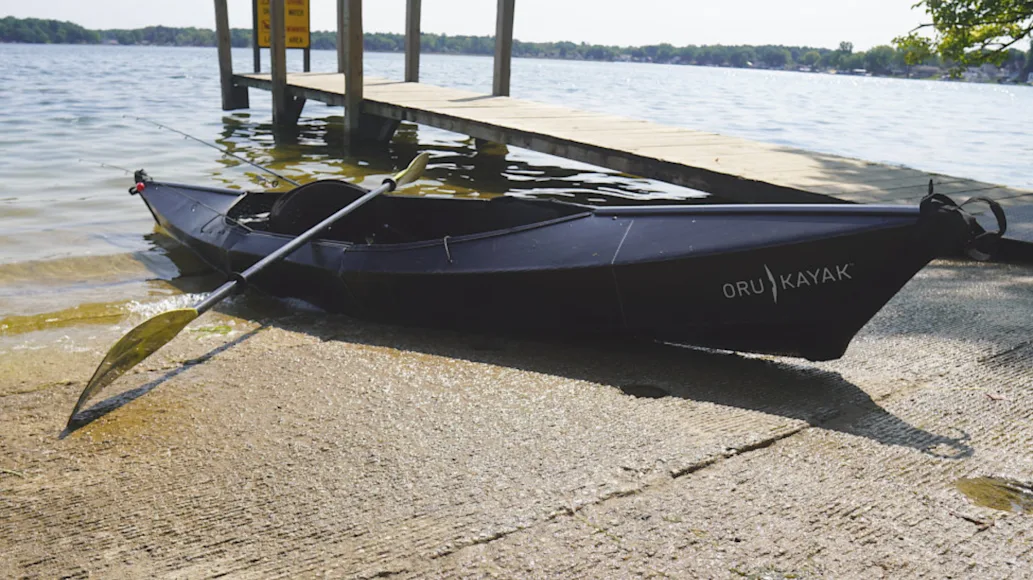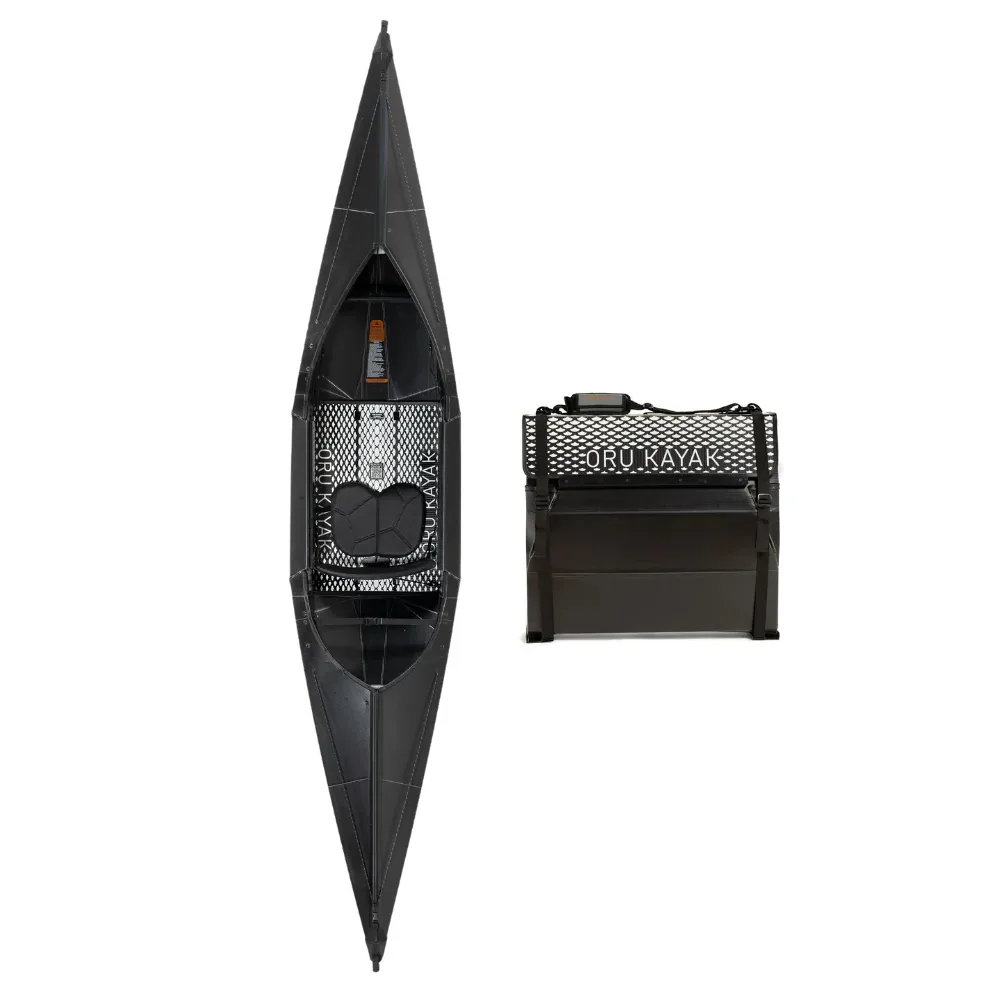We may earn revenue from the products available on this page and participate in affiliate programs. Learn more
The never-ending struggle of the kayak angler comes down to two things: storage and transportation. I've learned that the hard way. It was frustrating to spend over $1,200 on a trailer and license plate to haul my 12-foot fishing kayak around. Even after doing that, the trailer and kayak still take up a massive amount of garage space I wish was free. My only other option was to pay expensive storage unit fees—no thank you.
That's why it’s refreshing to see a niche market for portable kayaks appear. One of the more interesting ones is the Oru origami folding kayak. Made of lightweight polypropylene, these kayaks fold into a box, making them a breeze for toting to and from the water, and stowing away when you're done. However, I was a little skeptical. Could a foldable kayak be a serious tool for anglers or is it just a gimmick? Happy to do some research myself, I decided to take one of their models—the Oru Beach LT Sport—out for a spin.
Quick Overview
Specs
Weight: 28 pounds
Length (unfolded): 12’ 1”
Width: 29”
Dimensions (folded): 35” x 15” x 31”
Pros
Looks sharp
Ridiculously lightweight for a fishing kayak
Roomy, open, comfortable cockpit
Wide and stable
Easy to store and haul
Tracks well and is faster than expected
Cons
Expensive
Difficult setup and disassembly
Some quirks to the rail mount system
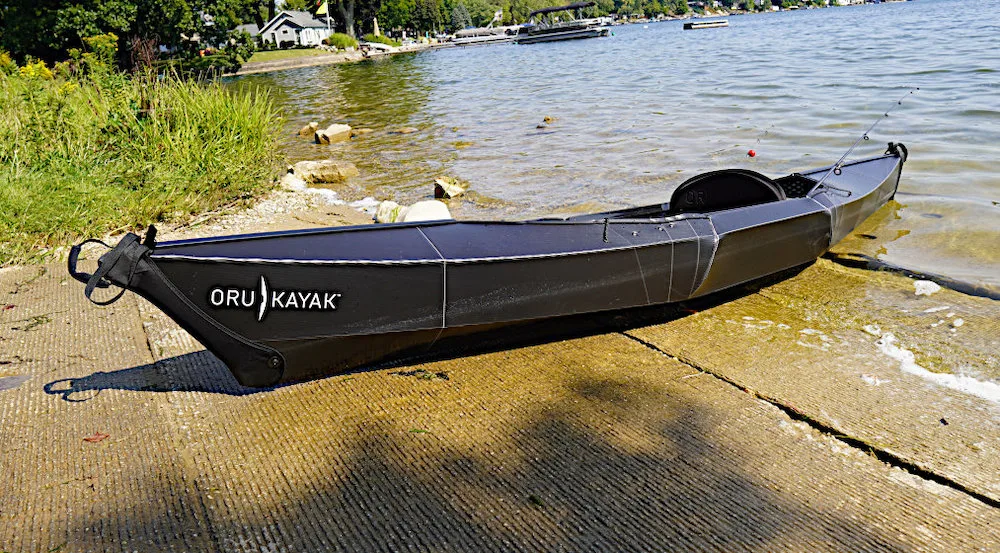
Testing and Analysis
First Impressions
Several years ago, I tested the Oru Inlet kayak, which is more of a casual paddling craft for calm waters. The Beach LT Sport is 2 two feet longer and has a much more open cockpit. The 29-inch width is only a few inches narrower than my Old Town. Overall, I found the Beach LT to be much more stable than the Inlet. The open cockpit is comfortable and roomy, with plenty of room for a tackle bag, multiple fishing rods, and accessories.
When folded, the 35-by-15-by-31-inch box is large but incredibly easy to stow away when not in use. It only took a minute for me to throw this thing in the back of my van before heading out. After fishing, it’s easy to store in a large closet or shelf. The 28-pound weight is a true joy to carry after wrangling my 110-pound fishing kayak onto a trailer.
This kayak's jet-black coloration is a noticeable upgrade over standard white. When I tested the Inlet, I noticed the waterline was visible through the polypropylene material, but that’s not the case with this kayak. The thick floorboard also makes this kayak feel much more rugged.
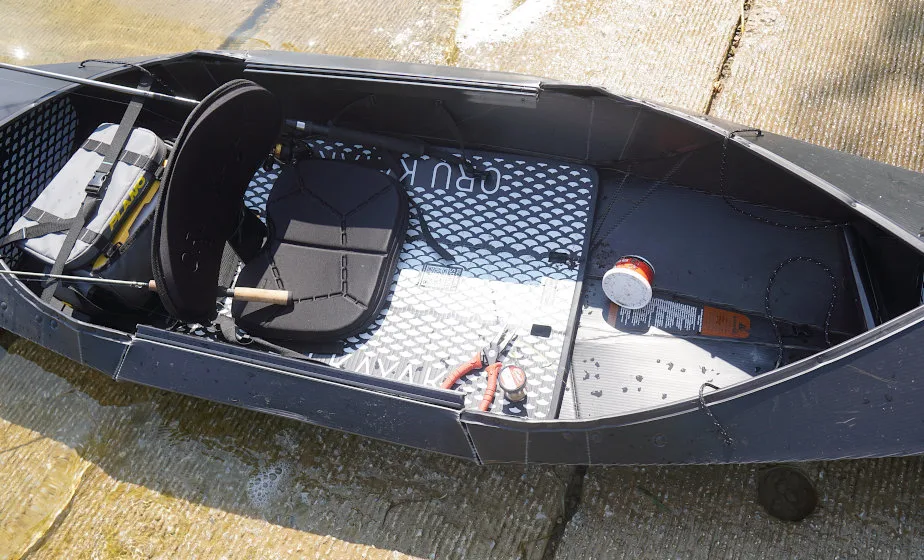
Construction
The polypropylene material of this kayak is the stuff usually used on yard signs. However, Oru has beefed it up a little. This kayak feels much more rugged than the Inlet I tested several years ago. I had no worries running it aground on rocks and the concrete boat ramp while fishing. I also wasn’t gentle while moving it between the ramp and my vehicle. I dropped it on my hard, compacted gravel drive several times. It didn’t show a single scratch.
One great thing about the material is how quickly it cleans and dries. I spilled soil from a tub of worms while catching a mess of panfish. When I got home, rinsing the dirt off only took a minute. It dried in the sun in less than an hour. It was much easier to clean than my hard-bodied kayaks, which always required extra scrubbing to remove stains.
The fabric nose cap is an issue, though. Once a lure gets snagged there, it can’t pop free. This happened more than once during my testing. I flattened the barb on several hooks to free them without cutting the fabric.
Storage and Portability
This kayak is incredible from a transportation and storage perspective. When I wanted to fish from the Oru, I threw it and my gear in the back of my van and went. No fuss, no muss. This kayak is an excellent option for anglers in apartments or who don’t have much garage space. It tucks nicely onto a shelf.
All the kayak's parts are also stowed in the folded body when not in use, making it impossible to misplace a small piece. This is an incredibly clever design. The shoulder strap makes it easy to pack this kayak into a place without a boat launch, opening bodies of water that were previously inaccessible to new possibilities.
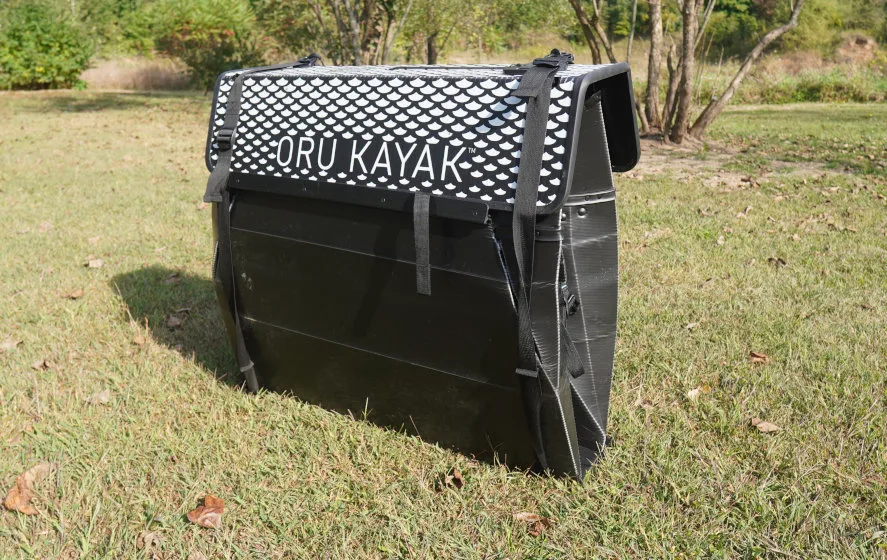
In many ways, this kayak is the solution many anglers have been waiting to see. It’s an excellent alternative to an expensive storage unit for anglers living in apartments or smaller homes. I also like this kayak as an option for urban anglers. It’s perfect for launching in city parks and backwoods lakes without a boat ramp. This kayak is so light that you can launch it from literally anywhere. Throw the padded strap over your shoulder, and it’s easy to carry the box into remote areas that were previously inaccessible. This is an excellent kayak for anyone who likes to fish areas untouched by others.
Setup
The Beach LT Sport is a bit challenging to set up. While some of it undoubtedly comes with practice, I thought it didn’t slip together as quickly or slickly as the Inlet. The same was true when it was time to take it down. I had to re-watch the instruction videos several times to get it down. One can argue that setup is always time-consuming with any kayak. In truth, the time I spent folding this thing was probably equal to what it takes to load and unload my 12-foot Old Town. It just depends on each person’s level of patience. I compare it to trying to fit a tent back into the original bag at the end of a camping trip.
Performance on the Water
Given its lightweight and foldable design, the Beach LT Sport handles better than expected. It tracks extremely well through the water and is much faster than expected. When I was paddling, the sharp bow cut through the water like a shark’s fin. It’s easy to spin the whole boat around in calm conditions to cast into tight cover. In truth, it turns faster than many hard-body kayaks I’ve used.
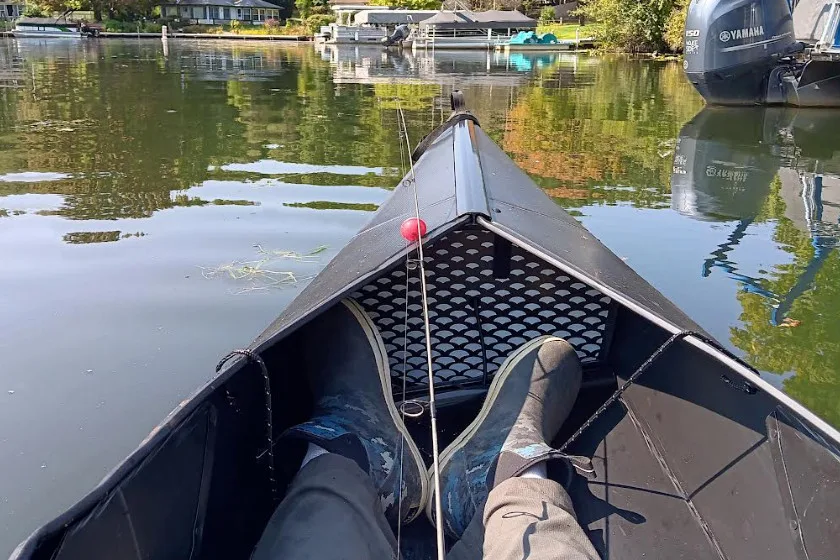
This craft is best in calm water conditions. I was going to test it on my favorite smallmouth stream, but I nixed that once I saw how the wind pushes this craft around. While I’m confident it can handle the current of a slower river or stream, fishing would be tough. I have a hard enough time with my pedal kayak on that stretch. I cannot imagine wrangling a 3- or 4-pound smallie while the current whips me downstream. I don’t think this part of the kayak is a dealbreaker, but it is something to keep in mind for river fishermen. I would stick to gentle currents for rivers and streams.
Fishing Use
I found the Oru Beach LT Sport is plenty capable of angling on the small inland lakes of southwest Michigan. When fishing tight pockets and narrow channels, it maneuvered beautifully. If it was calm, I didn’t need to put much effort into paddling to stay on top of the fish. On one of my trips, I found a pocket of sunfish in a channel. I sat there for over an hour, pulling up fish after fish in total comfort before I had a dozen eaters.
This kayak sits a little close to the waterline. Thus, I found using rods with shorter handles easier, especially when working fast lures like topwater. However, it’s a competent boat when battling larger fish. That 29-inch width I mentioned earlier is perfect for stability. I could easily turn around and pull my tackle bag from behind the seat without worrying about tipping.
This boat lacks more advanced angling features like transponders or anchor mounts, but I’m not sure it needs them. It’s more of a casual craft for fishing in the shallows. For anglers who want something simple, this kayak will do the job.
Accessory Rails
I’m not a fan of the Oru’s accessory rails. For one, I couldn’t get the rod holder into a spot where it wouldn’t interfere with paddling. I ended up not using it for most of the testing. Additionally, the rails are slick. That wouldn’t be an issue if it weren’t the natural place to rest the paddle while fishing. Oru’s paddles have smooth handles and slide easily on the surface. I remedied this by taking a paddle with more texture on the handle on subsequent trips.
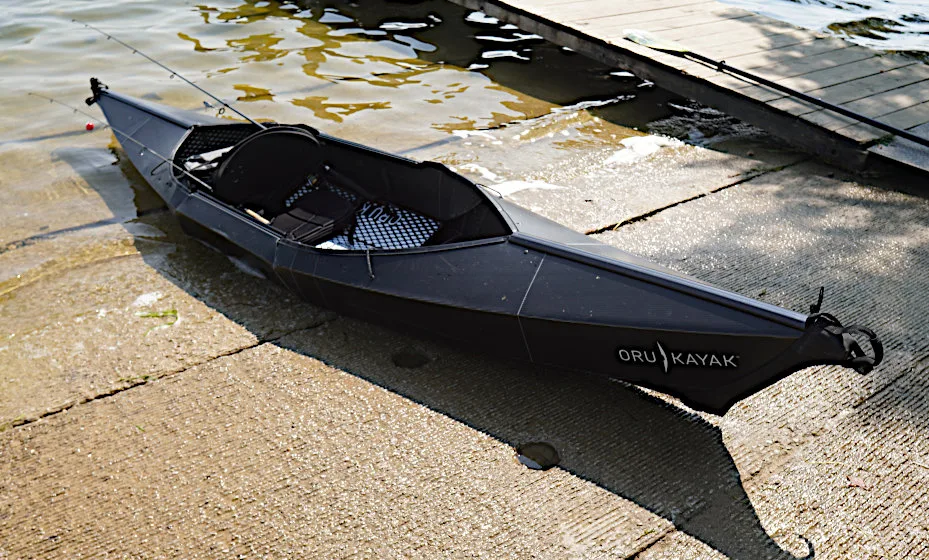
Verdict
Whether or not the Oru Beach LT Sport is worth the $1,500 price tag will be up for individual interpretation. However, this kayak is easier to transport and store than any other I’ve ever used. That gives it a serious edge, especially for anglers with limited space to store this kind of bulky equipment. While this folding kayak may skew slightly towards a more niche type of angler, I can’t deny it fishes just fine. It could be a regular fishing machine with a few minor modifications for rod holders. There are a ton of possibilities here for anglers wanting to reach areas that were previously inaccessible.
Why Trust Us
For more than 125 years, Field & Stream has been providing readers with honest and authentic coverage of outdoor gear. Our writers and editors eat, sleep, and breathe the outdoors, and that passion comes through in our product reviews. You can count on F&S to keep you up to date on the best new gear. And when we write about a product—whether it’s a bass lure or a backpack—we cover the good and the bad, so you know exactly what to expect before you decide to make a purchase.

